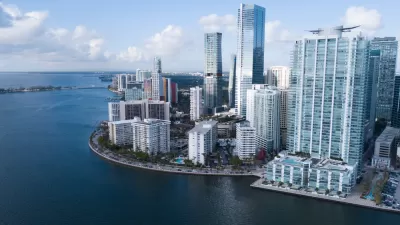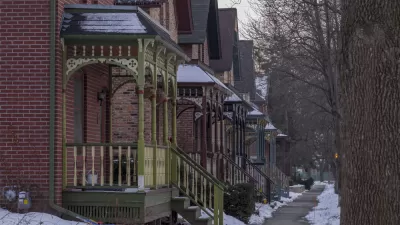Waterfront views and large parcels of vacant land should be a good urban revitalization in a growing city like Philadelphia, but the Central Delaware waterfront has fallen short of expectations.
Inga Saffron reviews the goals and results of a master plan approved in 2011 to remake the Central Delaware waterfront in Philadelphia.
The key approach of this plan, according to Saffron, was to aim for something different than the skyscraper-lined model of Vancouver and Miami.
By spacing out those smaller buildings, the thinking went, the city would create the beginnings of a true urban streetscape along Delaware Avenue. The mid-rises would populate the river, bringing just enough people to Delaware Avenue to support retail and justify adding a trolley line. The waterfront’s zoning was adjusted to make it easy to erect buildings under 25 stories, using a category called CMX-3.
While that seemed like a sound strategy at the time, Saffron makes the case that the results in 2019 have fallen far short of the ambitions described in 2011.
"Only one mid-rise has gone up over the last decade: PMC’s 16-story One Water Street, next to the Ben Franklin Bridge. Virtually every other residential project has been townhouses," reports Saffron. The maximum extent of the building envelope has not been realized, and the city is falling short of its vision for a "walkable, mixed-use riverfront neighborhood."
Saffron digs into more detail about why the townhomes that have been developed since 2011 fall short of the vision established by the Master Plan for the Central Delaware. There's even the development of a cap park to consider (work started in 2018), but even that hasn't convinced developers of adjacent projects to ditch to townhome development scheme.

Planetizen Federal Action Tracker
A weekly monitor of how Trump’s orders and actions are impacting planners and planning in America.

Chicago’s Ghost Rails
Just beneath the surface of the modern city lie the remnants of its expansive early 20th-century streetcar system.

San Antonio and Austin are Fusing Into one Massive Megaregion
The region spanning the two central Texas cities is growing fast, posing challenges for local infrastructure and water supplies.

Since Zion's Shuttles Went Electric “The Smog is Gone”
Visitors to Zion National Park can enjoy the canyon via the nation’s first fully electric park shuttle system.

Trump Distributing DOT Safety Funds at 1/10 Rate of Biden
Funds for Safe Streets and other transportation safety and equity programs are being held up by administrative reviews and conflicts with the Trump administration’s priorities.

German Cities Subsidize Taxis for Women Amid Wave of Violence
Free or low-cost taxi rides can help women navigate cities more safely, but critics say the programs don't address the root causes of violence against women.
Urban Design for Planners 1: Software Tools
This six-course series explores essential urban design concepts using open source software and equips planners with the tools they need to participate fully in the urban design process.
Planning for Universal Design
Learn the tools for implementing Universal Design in planning regulations.
planning NEXT
Appalachian Highlands Housing Partners
Mpact (founded as Rail~Volution)
City of Camden Redevelopment Agency
City of Astoria
City of Portland
City of Laramie





























